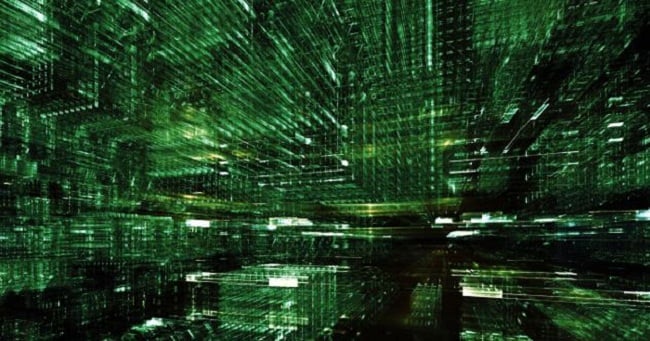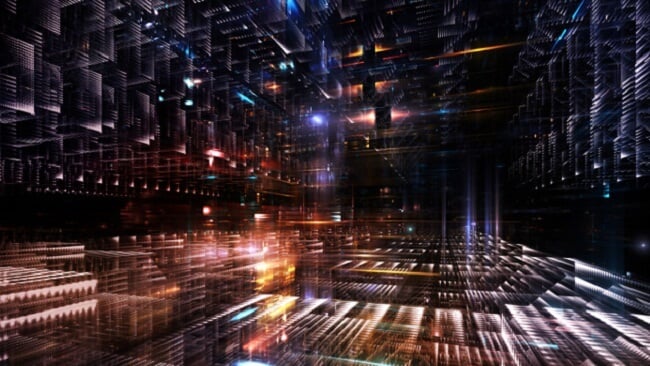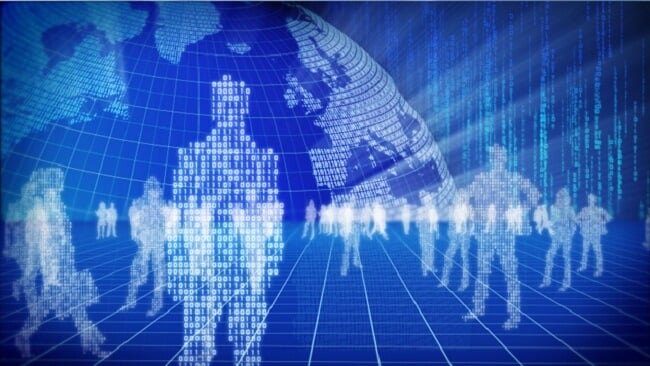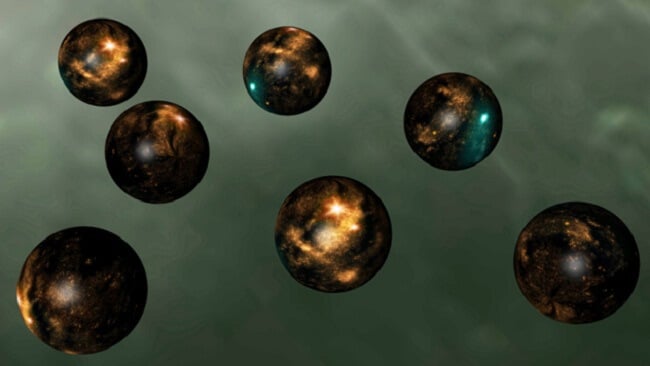- Get link
- X
- Other Apps
- Get link
- X
- Other Apps

A few thousand years ago Plato suggested: what we see may not be real at all. With the advent of computers, the idea gained a new life, especially in recent years, when the films “The Beginning”, “The Dark City” and the trilogy “The Matrix” appeared. Well, long before the appearance of these films, the idea that our “design” was virtual found a place in fantastic literature. Can our world really be literally modeled on a computer?
10. Life simulators

Computers can handle huge amounts of data, and some of the most productive and intensive solutions require modeling. Simulations involve the inclusion of many variables and artificial intelligence for analyzing and studying the results. Some simulations are purely playable. Some involve real-life situations, such as the spread of disease. Some games are historical simulators that can be gaming (for example, “Sid Meyer's Civilization”) or imitate the growth of the real life of society for a long time.
That's what simulations look like today, but computers are becoming more powerful and faster. Computational power is periodically doubled, and computers in 50 years may well be millions of times more powerful than today. Powerful computers will allow powerful simulations, especially historical ones. If computers become powerful enough, they can create a historical simulation in which self-aware creatures will not have the slightest idea that they are part of the program.
Think we are far from that? The Harvard Odyssey supercomputer can simulate 14 billion years in just a few months.
9. If someone could, he would do

Well, let's say, creating a universe inside a computer is quite possible. Would it be morally acceptable? People are complex creatures with their feelings and relationships. Suddenly, at a certain point in the creation of a false world of people, something will go wrong? Will not the responsibility for the universe fall on the shoulders of the creator, will it take an unbearable burden?
Maybe. But what does it matter? For some people, even the very idea of modeling will be tempting. And even if historical simulations were illegal, nothing would prevent one being from taking and creating our reality. It would take just one person who thought no more than any player in The Sims starting a new game.
People can also have good reasons for creating such simulations, except for entertainment. Humanity may face death and force scientists to create a massive diagnostic test for our world. Modeling can help them figure out what went wrong with the real world and how to fix it.
8. Obvious disadvantages

If the model is of sufficient quality, no one inside will understand that this is a simulation at all. If you had grown a brain in a jar and made him react to stimuli, he would not know what is in the jar. He would consider himself a living, breathing and active person.
But even simulations can have shoals, right? Didn't you yourself notice some flaws, “failures in the matrix”?
Perhaps we see such failures in everyday life. The matrix offers an example of deja vu - when something seems inexplicably familiar. Simulations may crash like a scratched disc. Supernatural elements, ghosts and wonders can also be failures. According to the theory of modeling, people do observe these phenomena, but this is a consequence of errors in the code.
There are a lot of such testimonies on the Internet, and at least 99 percent of them are nonsense, some recommend keeping your eyes and mind open, and maybe something will be revealed. In the end, it's just a theory.
7. Mathematics is at the core of our life.

Everything in the universe can be counted in some way. Even life is quantified. The Human Genome Project, during which the sequence of chemical base pairs that make up human DNA was calculated, was resolved using computers. All the secrets of the universe are solved with the help of mathematics. Our Universe is better explained in the language of mathematics than in words.
If everything is mathematics, everything can be broken down into binary code. So, if computers and data reach certain heights, can a functional person be recreated based on the genome inside the computer? And if you build one such person, why not create a whole world?
Scientists suggest that someone may have already done this and created our world. To determine whether or not we live in a simulation, researchers conduct serious research, study the mathematics that makes up our Universe.
6. Anthropic principle

The existence of people is most amazing. To start life on Earth, we need everything to be in order. We are at a great distance from the sun, the atmosphere suits us, gravity is strong enough. And although in theory there can be many other planets with such conditions, life seems even more amazing when you look beyond the limits of the planet. If any of the cosmic factors like dark energy were a little stronger, life, perhaps, would not exist either here or anywhere else in the Universe.
The anthropic principle asks the question: “Why? Why do these conditions suit us so well? ”
One explanation: the conditions were intentionally set to give us life. Each suitable factor was set in a fixed state in a certain laboratory of universal scales. Factors connected to the universe, and the simulation began. Therefore, we exist, and our individual planet is developing as it is now.
The obvious consequence is that there may not be people on the other side of the model. Other creatures that hide their presence and play in their cosmic Sims. Perhaps alien life is fully aware of how the program works, and it’s easy for them to become invisible to us.
5. Parallel universes

The theory of parallel worlds, or multiverse, implies an infinite number of universes with an infinite set of parameters. Imagine the floors of a residential building. Universes make up a multiverse just like floors - a building, they have a common structure, but they differ from each other. Jorge Luis Borges compared the multiverse with the library. The library contains an infinite number of books, some may differ per letter, and some keep incredible stories.
Such a theory introduces some confusion in our understanding of life. But if there really are many universes, where did they come from? Why are there so many? How?
If we are in a simulation, the numerous universes are numerous simulations running at the same time. Each simulation has its own set of variables, and this is not accidental. The creator of the model includes various variables for testing different scenarios and observes various results.
4. The Fermi Paradox

Our planet is one of many capable of supporting life, and our Sun is rather young relative to the whole Universe. Obviously, life should be everywhere, both on the planets, where life began to develop simultaneously with ours, and on those that originated earlier.
Moreover, people had the courage to go into space, so other civilizations should have made such an attempt? There are billions of galaxies that are billions of years older than ours, which means that at least one should have become a "frog traveler." Since there are all conditions for life on Earth, it means that our planet in general could become a target for colonization at a certain moment.
However, we did not find any traces, hints or smells of other intelligent life in the universe. The Fermi paradox sounds simple: “Where is everyone?”.
Modeling theory can provide several answers. If life should be everywhere, but only exists on Earth, we are in a simulation. The one who is responsible for modeling, just decided to watch how people act alone.
Multiverse theory says that life on other planets exists - in most models of universes. We here, for example, live in a quiet simulation, such lonely people in the universe. Returning to the anthropic principle, we can say that the universe was created only for us.
Another theory, the planetarium hypothesis, offers another possible answer. Modeling assumes a mass of inhabited planets, each of which thinks that it is one in the Universe so populated. It turns out that the purpose of such a simulation is to cultivate the ego of a separate civilization and see what happens.
3. God is a programmer

People have long discussed the idea of the creator god who created our world. Some represent a particular god as a bearded man sitting in the clouds, but in theory modeling by god or anyone else can be an ordinary programmer pressing buttons on the keyboard.
As we found out, a programmer can create a world based on a simple binary code. The only question is why does he program people to serve his creator, as most religions say.
It may be intentional or unintentional. Perhaps the programmer wants us to know that he or she exists, and wrote code to give us an innate sense that everything was created. Perhaps he did not and did not want to, but intuitively we assume the existence of a creator.
The idea of God as a programmer is developed in two ways. First: the code began to live, gave everything to evolve and the simulation led us to where we are today. Second, the literal creationism is to blame. According to the Bible, God created the world and life within seven days, but in our case he used a computer, not cosmic forces.
2. Outside the Universe

What is outside the universe? According to modeling theory, the answer would be a supercomputer surrounded by developed beings. But even more insane things are possible.
Those who control the models may be just as unreal as we are. There may be multiple layers in the simulation. As suggested by the Oxford philosopher Nick Bostrom, “the post-people who developed our simulation can be modeled themselves, and their creators, in turn, too. There may be many levels of reality, and their number may increase over time. ”
Imagine you sat down to play The Sims and played until your characters created their own game. Their Sims have repeated this process, and you are actually part of an even greater simulation.
The question remains: who created the real world? This idea is so far from our life that it seems impossible to talk about this topic. But if modeling theory can at least explain the limited size of our Universe and understand what is beyond its limits ... this is a good start in clarifying the nature of being.
1. Fake people make it easier to simulate.

Even if computers are becoming more powerful, the universe may be too complex to fit in one of them. Each of the seven billion people is currently quite complicated to compete with any computer imagination possible. And we represent an infinitely small part of a vast universe that contains billions of galaxies. It will be incredibly difficult, if not impossible, to take into account many variables.
But the simulated world does not need to be as complex as it seems. To become convincing, the model will need several detailed indicators and a lot of barely defined secondary players. Imagine one of the games in the GTA series. It holds hundreds of people, but you interact with just a few. Life can be like this. There are you, your loved ones and relatives, but all those you meet on the street may not be real. They may have a few thoughts and a lack of emotion. They are like that “woman in red dress”, metonymy, image, sketch.
Let's take into account the analogy of the video game. Such games contain huge worlds, but only your current location at the moment has a meaning, it takes action. Reality can follow the same scenario. Areas outside the view can be stored in memory and appear only when necessary. Tremendous savings in computing power. What about remote areas that you never visit, for example, in other galaxies? In the simulation, they generally can not run. They need convincing images in case they want to look at them.
Well, people on the streets or distant stars are one. But you have no evidence that you exist, at least in the form in which you present yourself. We believe that the past happened because we have memories and because we have photos and books. But what if all this code is just written? What if your life is updated every time you blink?
The most interesting thing is that it is impossible to prove or disprove.
The article is based on materials .
- Get link
- X
- Other Apps
Comments
Post a Comment